TOYOTA RAV4 PHEV 2021 Owners Manual
Manufacturer: TOYOTA, Model Year: 2021, Model line: RAV4 PHEV, Model: TOYOTA RAV4 PHEV 2021Pages: 666, PDF Size: 161.28 MB
Page 101 of 666
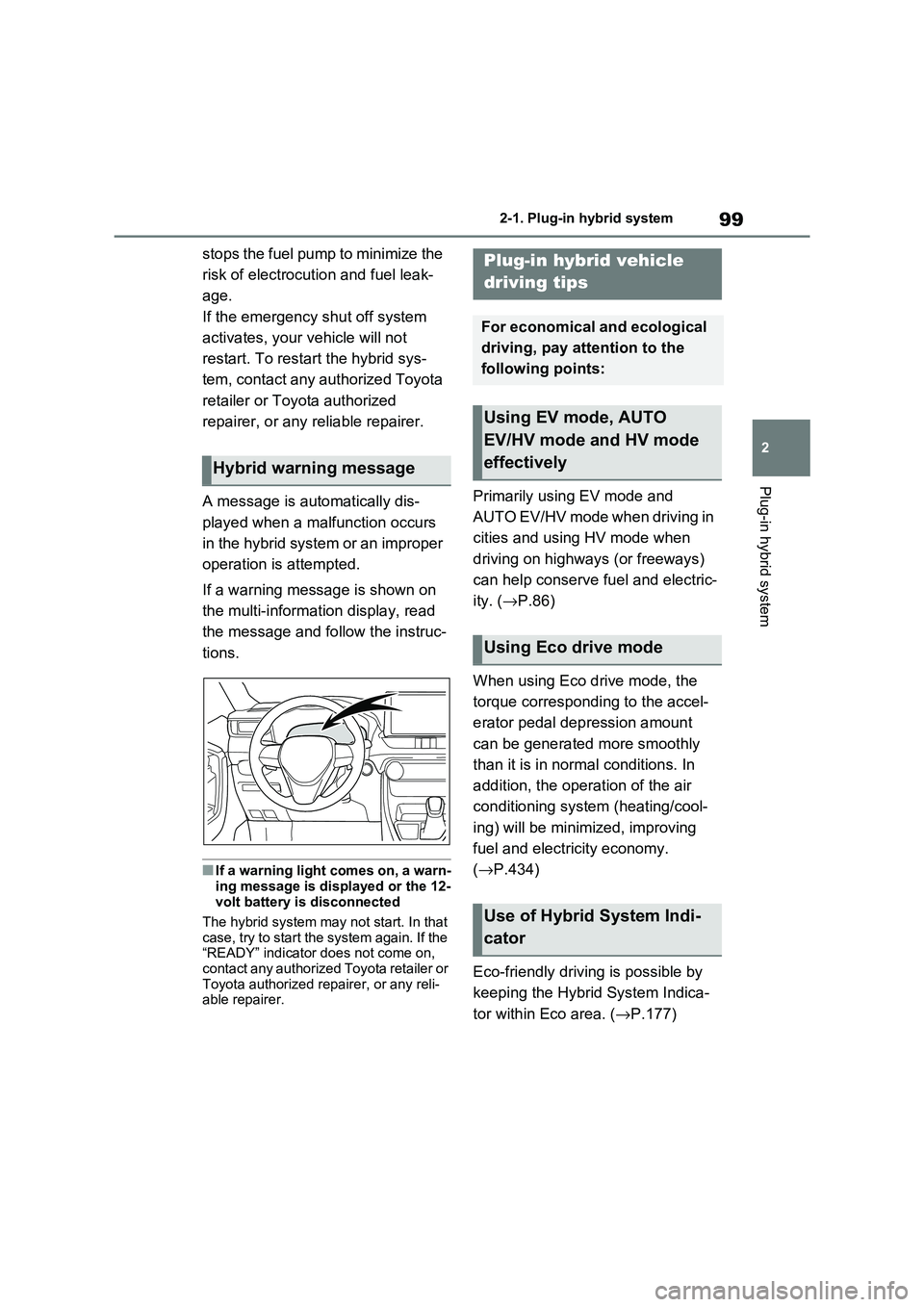
99
2
2-1. Plug-in hybrid system
Plug-in hybrid system
stops the fuel pump to minimize the
risk of electrocuti on and fuel leak-
age.
If the emergency shut off system
activates, your vehicle will not
restart. To restart the hybrid sys -
tem, contact any authorized Toyota
retailer or Toyota authorized
repairer, or any reliable repairer.
A message is automatically dis -
played when a malfunction occurs
in the hybrid system or an improper
operation is attempted.
If a warning message is shown on
the multi-informat ion display, read
the message and follow the instruc -
tions.
■If a warning light comes on, a warn - ing message is displayed or the 12-
volt battery is disconnected
The hybrid system may not start. In that
case, try to start the system again. If the “READY” indicator does not come on,
contact any authorized Toyota retailer or
Toyota authorized repairer, or any reli - able repairer.
Primarily using EV mode and
AUTO EV/HV mode when driving in
cities and using HV mode when
driving on highways (or freeways)
can help conserve fuel and electric -
ity. ( →P.86)
When using Eco drive mode, the
torque corresponding to the accel -
erator pedal depression amount
can be generated more smoothly
than it is in normal conditions. In
addition, the operation of the air
conditioning system (heating/cool -
ing) will be minim ized, improving
fuel and electricity economy.
( →P.434)
Eco-friendly driving is possible by
keeping the Hybrid System Indica -
tor within Eco area. ( →P.177)
Hybrid warning message
Plug-in hybrid vehicle
driving tips
For economical and ecological
driving, pay attention to the
following points:
Using EV mode, AUTO
EV/HV mode and HV mode
effectively
Using Eco drive mode
Use of Hybrid System Indi -
cator
Page 102 of 666
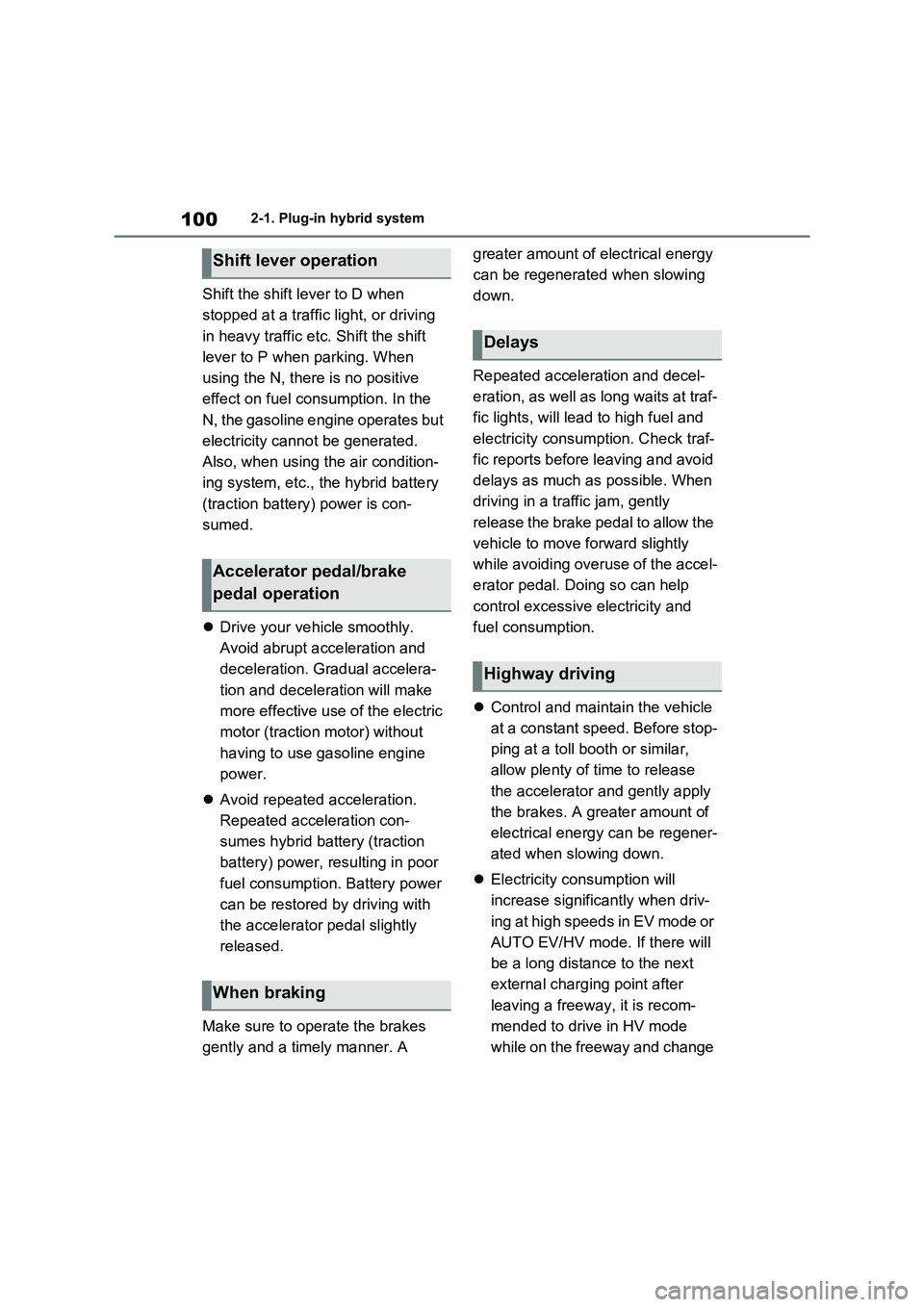
1002-1. Plug-in hybrid system
Shift the shift lever to D when
stopped at a traffic light, or driving
in heavy traffic etc. Shift the shift
lever to P when parking. When
using the N, there is no positive
effect on fuel consumption. In the
N, the gasoline engine operates but
electricity canno t be generated.
Also, when using the air condition -
ing system, etc., the hybrid battery
(traction battery) power is con -
sumed.
Drive your vehicle smoothly.
Avoid abrupt acceleration and
deceleration. Gradual accelera -
tion and deceler ation will make
more effective use of the electric
motor (traction motor) without
having to use gasoline engine
power.
Avoid repeated acceleration.
Repeated acceleration con -
sumes hybrid battery (traction
battery) power, resulting in poor
fuel consumption. Battery power
can be restored by driving with
the accelerator pedal slightly
released.
Make sure to operate the brakes
gently and a ti mely manner. A
greater amount of electrical energy
can be regenerated when slowing
down.
Repeated acceler ation and decel-
eration, as well as long waits at traf -
fic lights, will lead to high fuel and
electricity consumption. Check traf -
fic reports before leaving and avoid
delays as much as possible. When
driving in a traffic jam, gently
release the brake pedal to allow the
vehicle to move forward slightly
while avoiding overuse of the accel -
erator pedal. Doing so can help
control excessive electricity and
fuel consumption.
Control and maintain the vehicle
at a constant speed. Before stop -
ping at a toll booth or similar,
allow plenty of time to release
the accelerator and gently apply
the brakes. A greater amount of
electrical energy can be regener -
ated when slowing down.
Electricity consumption will
increase significantly when driv -
ing at high speeds in EV mode or
AUTO EV/HV mode. If there will
be a long distance to the next
external charging point after
leaving a freewa y, it is recom-
mended to drive in HV mode
while on the freeway and change
Shift lever operation
Accelerator pedal/brake
pedal operation
When braking
Delays
Highway driving
Page 103 of 666
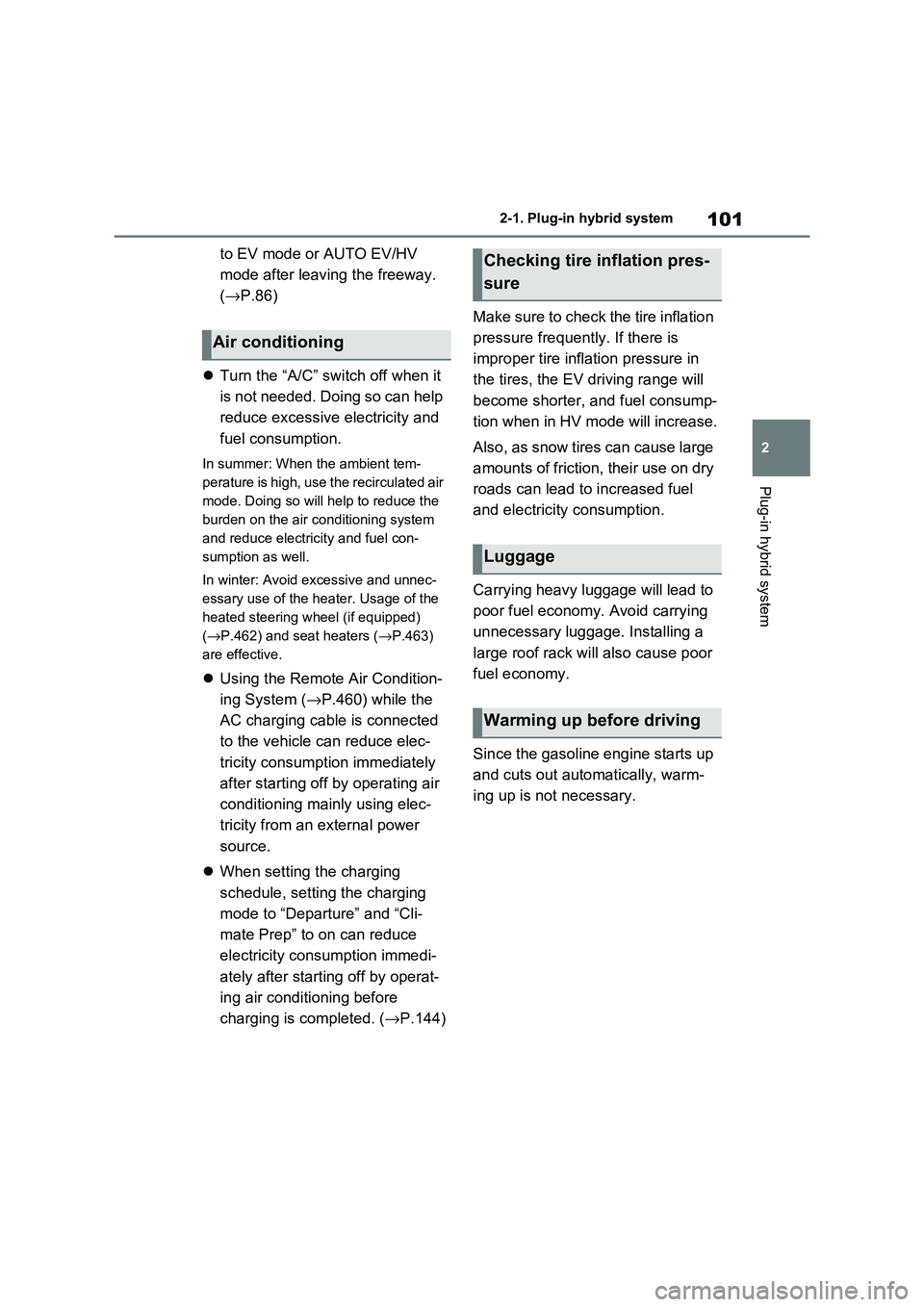
101
2
2-1. Plug-in hybrid system
Plug-in hybrid system
to EV mode or AUTO EV/HV
mode after leaving the freeway.
( →P.86)
Turn the “A/C” switch off when it
is not needed. Doing so can help
reduce excessive e lectricity and
fuel consumption.
In summer: When the ambient tem -
perature is high, use the recirculated air
mode. Doing so will help to reduce the
burden on the air co nditioning system
and reduce electricity and fuel con -
sumption as well.
In winter: Avoid excessive and unnec-
essary use of the heater. Usage of the
heated steering w heel (if equipped)
( →P.462) and seat heaters (→P.463)
are effective.
Using the Remote Air Condition-
ing System ( →P.460) while the
AC charging cable is connected
to the vehicle can reduce elec -
tricity consumption immediately
after starting off by operating air
conditioning mainly using elec -
tricity from an external power
source.
When setting the charging
schedule, setting the charging
mode to “Departure” and “Cli -
mate Prep” to on can reduce
electricity consumption immedi -
ately after starting off by operat -
ing air conditioning before
charging is completed. ( →P.144)
Make sure to check the tire inflation
pressure frequen tly. If there is
improper tire inflation pressure in
the tires, the EV driving range will
become shorter, and fuel consump-
tion when in HV mode will increase.
Also, as snow tires can cause large
amounts of friction, their use on dry
roads can lead to increased fuel
and electricity consumption.
Carrying heavy luggage will lead to
poor fuel economy. Avoid carrying
unnecessary lugga ge. Installing a
large roof rack will also cause poor
fuel economy.
Since the gasoline engine starts up
and cuts out automatically, warm -
ing up is not necessary.
Air conditioning
Checking tire inflation pres -
sure
Luggage
Warming up before driving
Page 104 of 666
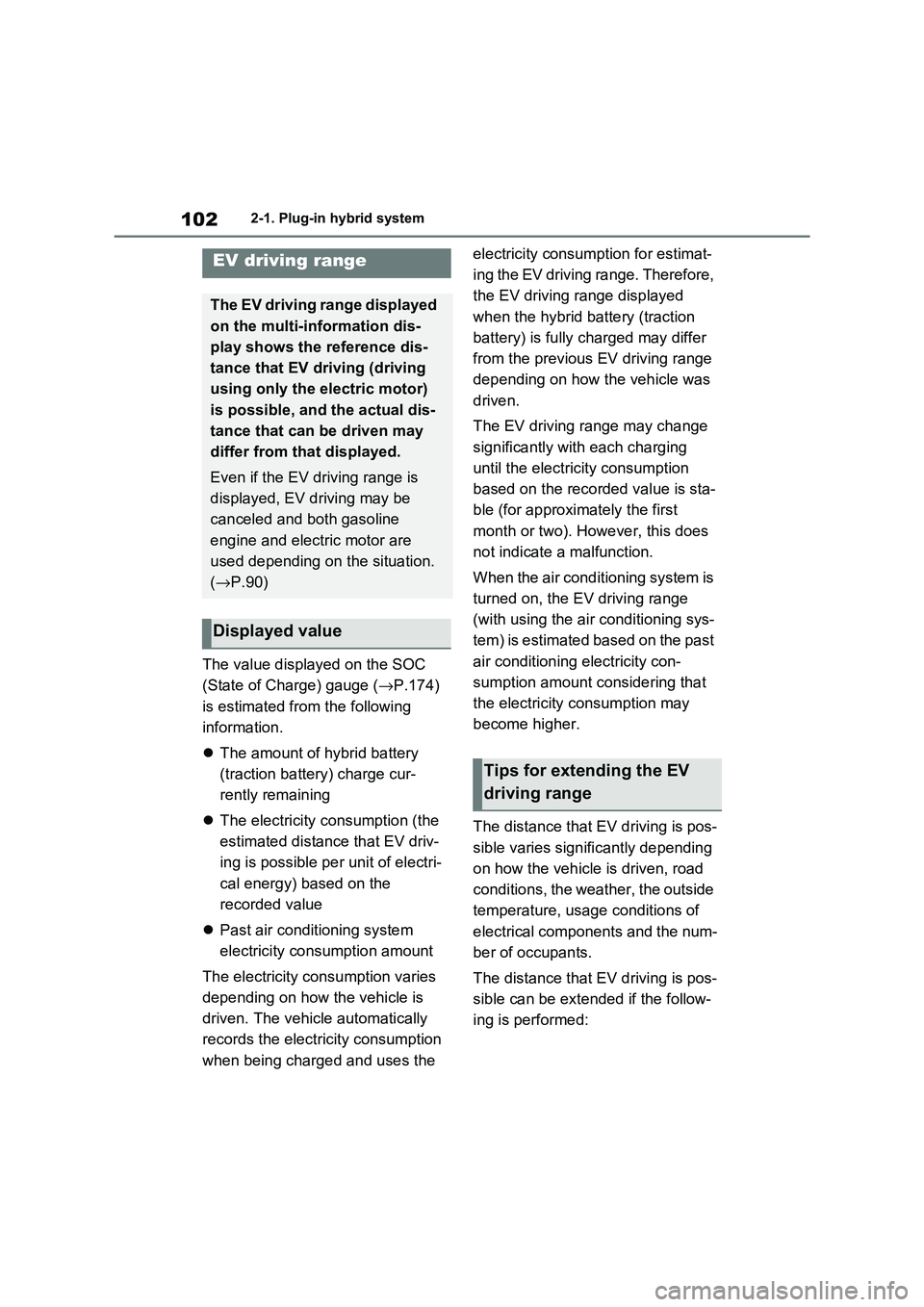
1022-1. Plug-in hybrid system
The value displayed on the SOC
(State of Charge) gauge ( →P.174)
is estimated from the following
information.
The amount of hybrid battery
(traction battery) charge cur -
rently remaining
The electricity consumption (the
estimated distan ce that EV driv-
ing is possible pe r unit of electri-
cal energy) based on the
recorded value
Past air conditioning system
electricity consumption amount
The electricity co nsumption varies
depending on how the vehicle is
driven. The vehicle automatically
records the electricity consumption
when being charged and uses the
electricity consumption for estimat -
ing the EV driving range. Therefore,
the EV driving ra nge displayed
when the hybrid battery (traction
battery) is fully charged may differ
from the previous EV driving range
depending on how the vehicle was
driven.
The EV driving r ange may change
significantly with each charging
until the electricity consumption
based on the recorded value is sta -
ble (for approximately the first
month or two). However, this does
not indicate a malfunction.
When the air conditioning system is
turned on, the EV driving range
(with using the air conditioning sys -
tem) is estimated based on the past
air conditioning electricity con -
sumption amount considering that
the electricity consumption may
become higher.
The distance that EV driving is pos -
sible varies signi ficantly depending
on how the vehicle is driven, road
conditions, the weather, the outside
temperature, usage conditions of
electrical components and the num -
ber of occupants.
The distance that EV driving is pos -
sible can be extended if the follow -
ing is performed:
EV driving range
The EV driving range displayed
on the multi-information dis -
play shows the reference dis -
tance that EV driving (driving
using only the electric motor)
is possible, and the actual dis-
tance that can be driven may
differ from that displayed.
Even if the EV dr iving range is
displayed, EV driving may be
canceled and both gasoline
engine and electric motor are
used depending on the situation.
( →P.90)
Displayed value
Tips for extending the EV
driving range
Page 105 of 666
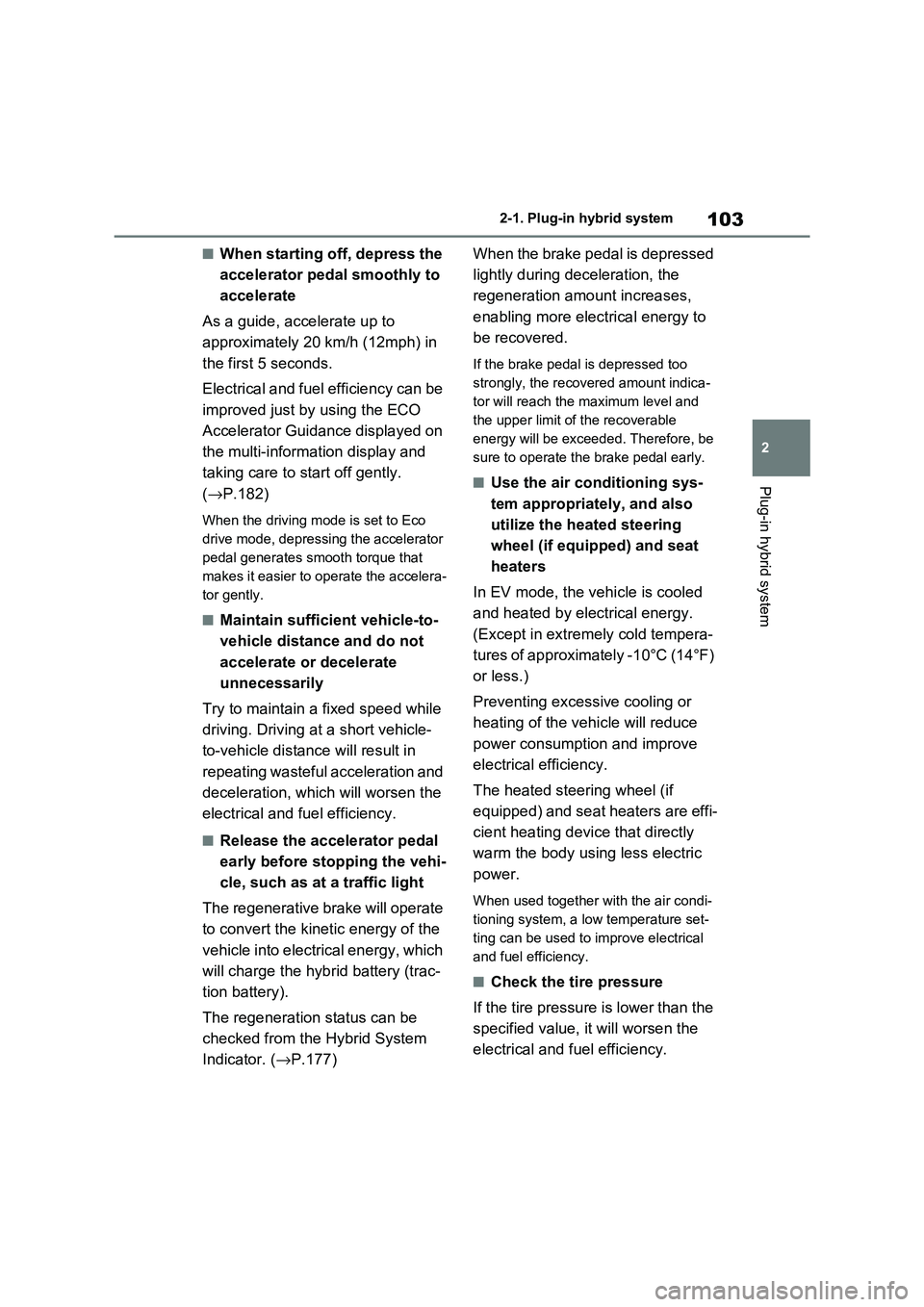
103
2
2-1. Plug-in hybrid system
Plug-in hybrid system
■When starting off, depress the
accelerator pedal smoothly to
accelerate
As a guide, acce lerate up to
approximately 20 km/h (12mph) in
the first 5 seconds.
Electrical and fuel efficiency can be
improved just by using the ECO
Accelerator Guidance displayed on
the multi-informat ion display and
taking care to start off gently.
( →P.182)
When the driving mode is set to Eco
drive mode, depressing the accelerator
pedal generates smooth torque that
makes it easier to operate the accelera -
tor gently.
■Maintain sufficient vehicle-to-
vehicle distance and do not
accelerate or decelerate
unnecessarily
Try to maintain a fixed speed while
driving. Driving at a short vehicle-
to-vehicle distance will result in
repeating wasteful acceleration and
deceleration, which will worsen the
electrical and fuel efficiency.
■Release the accelerator pedal
early before stopping the vehi -
cle, such as at a traffic light
The regenerative brake will operate
to convert the kinetic energy of the
vehicle into electrical energy, which
will charge the hyb rid battery (trac-
tion battery).
The regeneration status can be
checked from the Hybrid System
Indicator. ( →P.177)
When the brake pedal is depressed
lightly during deceleration, the
regeneration amount increases,
enabling more electrical energy to
be recovered.
If the brake pedal is depressed too
strongly, the recovered amount indica -
tor will reach the maximum level and
the upper limit of the recoverable
energy will be exceeded. Therefore, be
sure to operate the brake pedal early.
■Use the air co nditioning sys-
tem appropriately, and also
utilize the heated steering
wheel (if equipped) and seat
heaters
In EV mode, the vehicle is cooled
and heated by electrical energy.
(Except in extremely cold tempera -
tures of approximately -10°C (14°F)
or less.)
Preventing excessive cooling or
heating of the vehicle will reduce
power consumption and improve
electrical efficiency.
The heated steering wheel (if
equipped) and seat heaters are effi -
cient heating device that directly
warm the body using less electric
power.
When used together with the air condi -
tioning system, a low temperature set-
ting can be used to improve electrical
and fuel efficiency.
■Check the tire pressure
If the tire pressure is lower than the
specified value, i t will worsen the
electrical and fuel efficiency.
Page 106 of 666
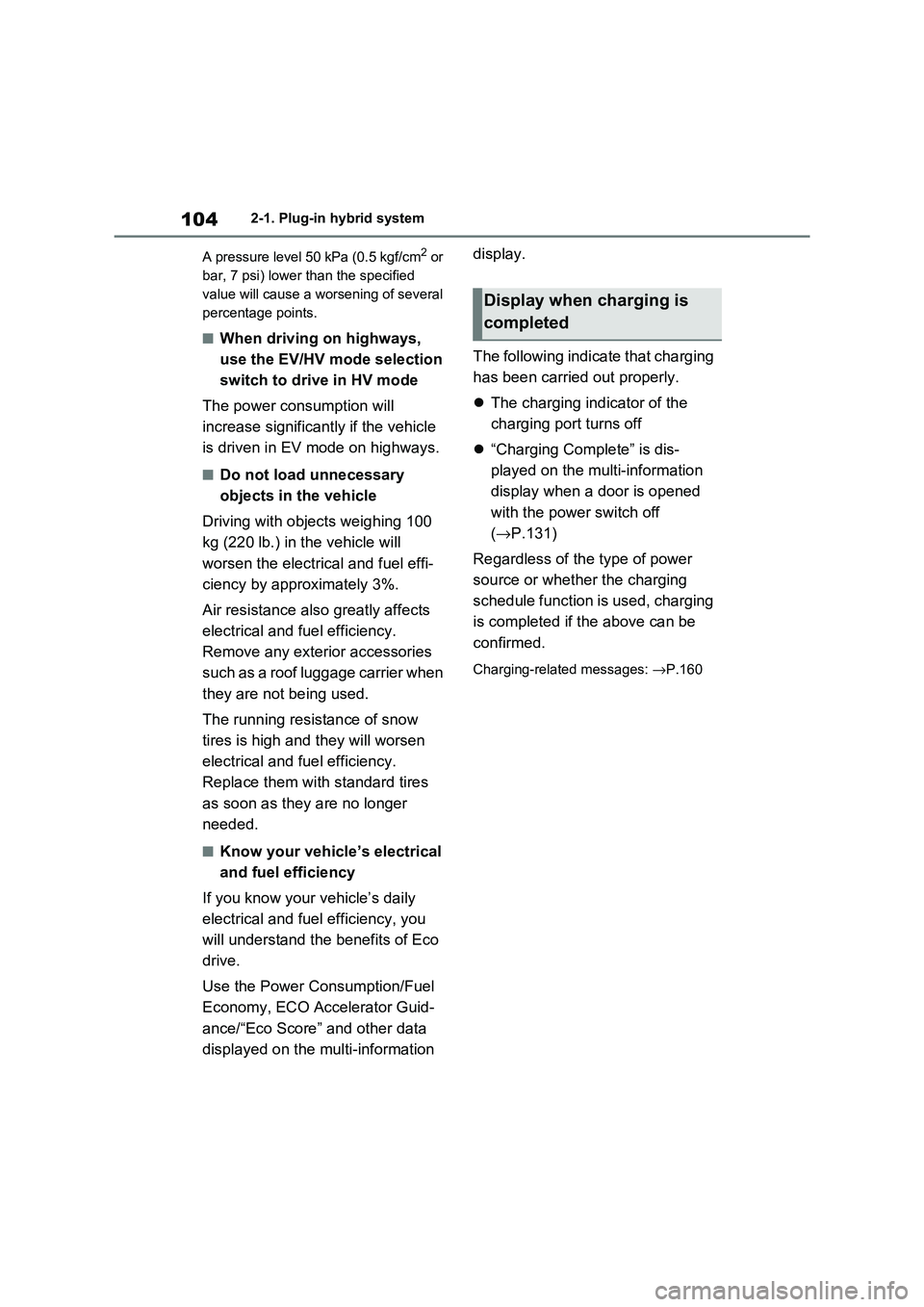
1042-1. Plug-in hybrid system
A pressure level 50 kPa (0.5 kgf/cm2 or
bar, 7 psi) lower than the specified
value will cause a worsening of several
percentage points.
■When driving on highways,
use the EV/HV mode selection
switch to drive in HV mode
The power consumption will
increase significantly if the vehicle
is driven in EV mode on highways.
■Do not load unnecessary
objects in the vehicle
Driving with objects weighing 100
kg (220 lb.) in the vehicle will
worsen the electrical and fuel effi -
ciency by approximately 3%.
Air resistance also greatly affects
electrical and fuel efficiency.
Remove any exterior accessories
such as a roof luggage carrier when
they are not being used.
The running resistance of snow
tires is high and they will worsen
electrical and fuel efficiency.
Replace them with standard tires
as soon as they are no longer
needed.
■Know your vehicle’s electrical
and fuel efficiency
If you know your vehicle’s daily
electrical and fuel efficiency, you
will understa nd the benefits of Eco
drive.
Use the Power Consumption/Fuel
Economy, ECO Accelerator Guid -
ance/“Eco Score” and other data
displayed on the multi-information
display.
The following indicate that charging
has been carried out properly.
The charging indicator of the
charging port turns off
“Charging Complete” is dis-
played on the multi-information
display when a door is opened
with the power switch off
( →P.131)
Regardless of the type of power
source or whether the charging
schedule function is used, charging
is completed if the above can be
confirmed.
Charging-related messages: →P.160
Display when charging is
completed
Page 107 of 666
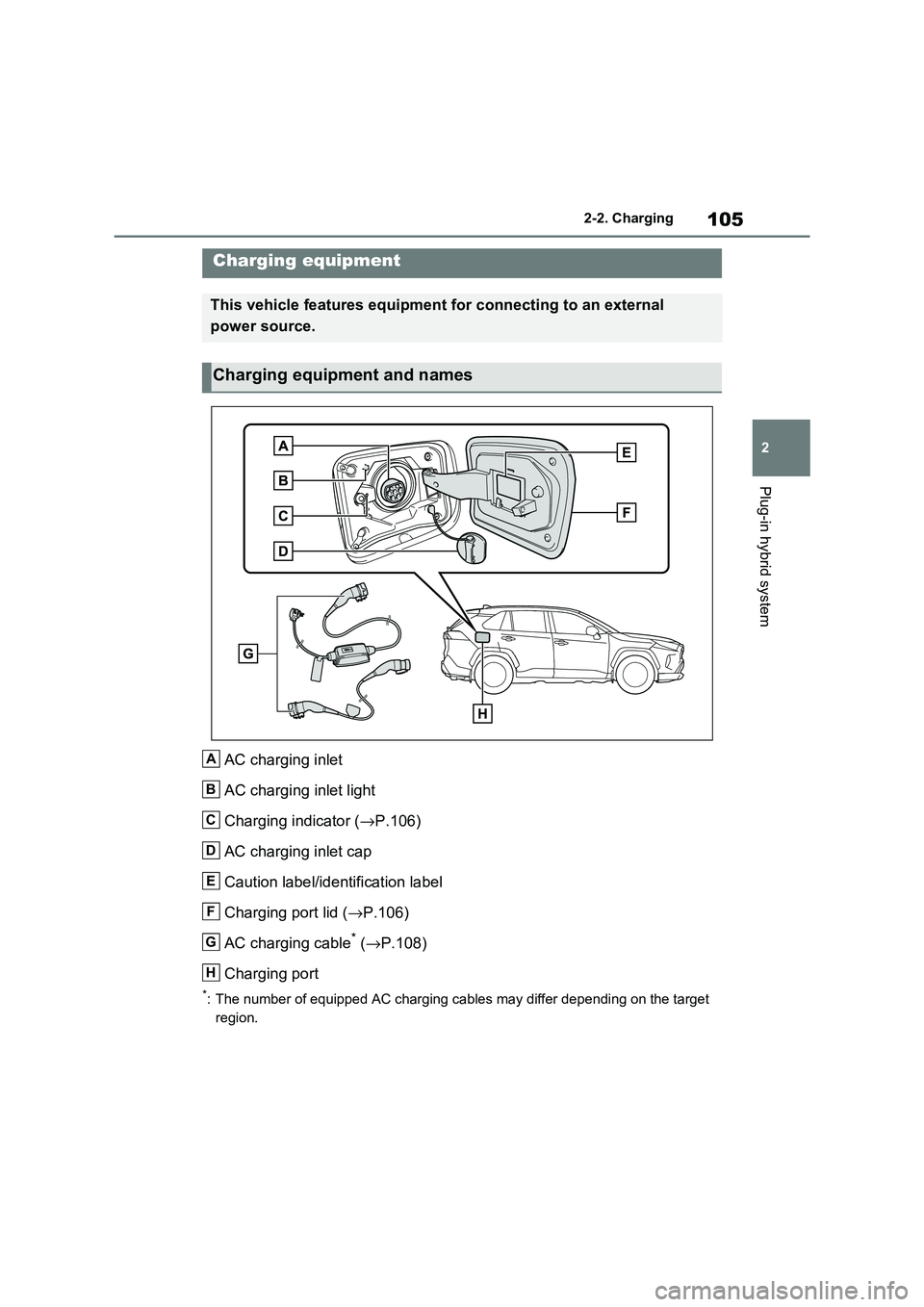
105
2
2-2. Charging
Plug-in hybrid system
2-2.Charging
AC charging inlet
AC charging inlet light
Charging indicator ( →P.106)
AC charging inlet cap
Caution label/identification label
Charging port lid ( →P.106)
AC charging cable* ( →P.108)
Charging port
*: The number of equipped AC chargin g cables may differ depending on the target
region.
Charging equipment
This vehicle features equipment for connecting to an external
power source.
Charging equipment and names
A
B
C
D
E
F
G
H
Page 108 of 666
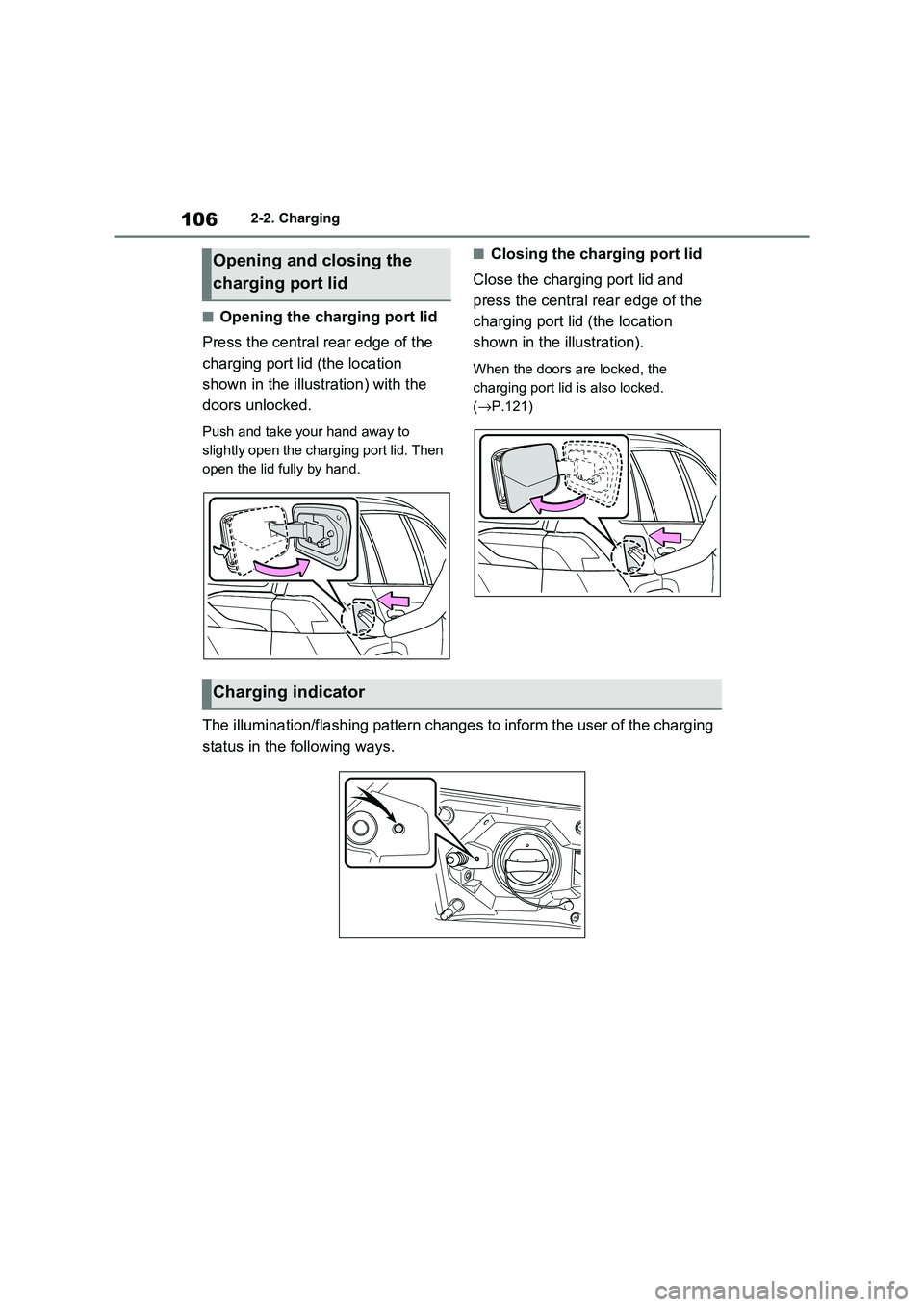
1062-2. Charging
■Opening the charging port lid
Press the central rear edge of the
charging port lid (the location
shown in the illust ration) with the
doors unlocked.
Push and take your hand away to
slightly open the charging port lid. Then
open the lid fully by hand.
■Closing the charging port lid
Close the charging port lid and
press the central rear edge of the
charging port lid (the location
shown in the illustration).
When the doors are locked, the
charging port lid i s also locked.
( →P.121)
The illumination/flashing pattern changes to inform the user of the charging
status in the following ways.
Opening and closing the
charging port lid
Charging indicator
Page 109 of 666
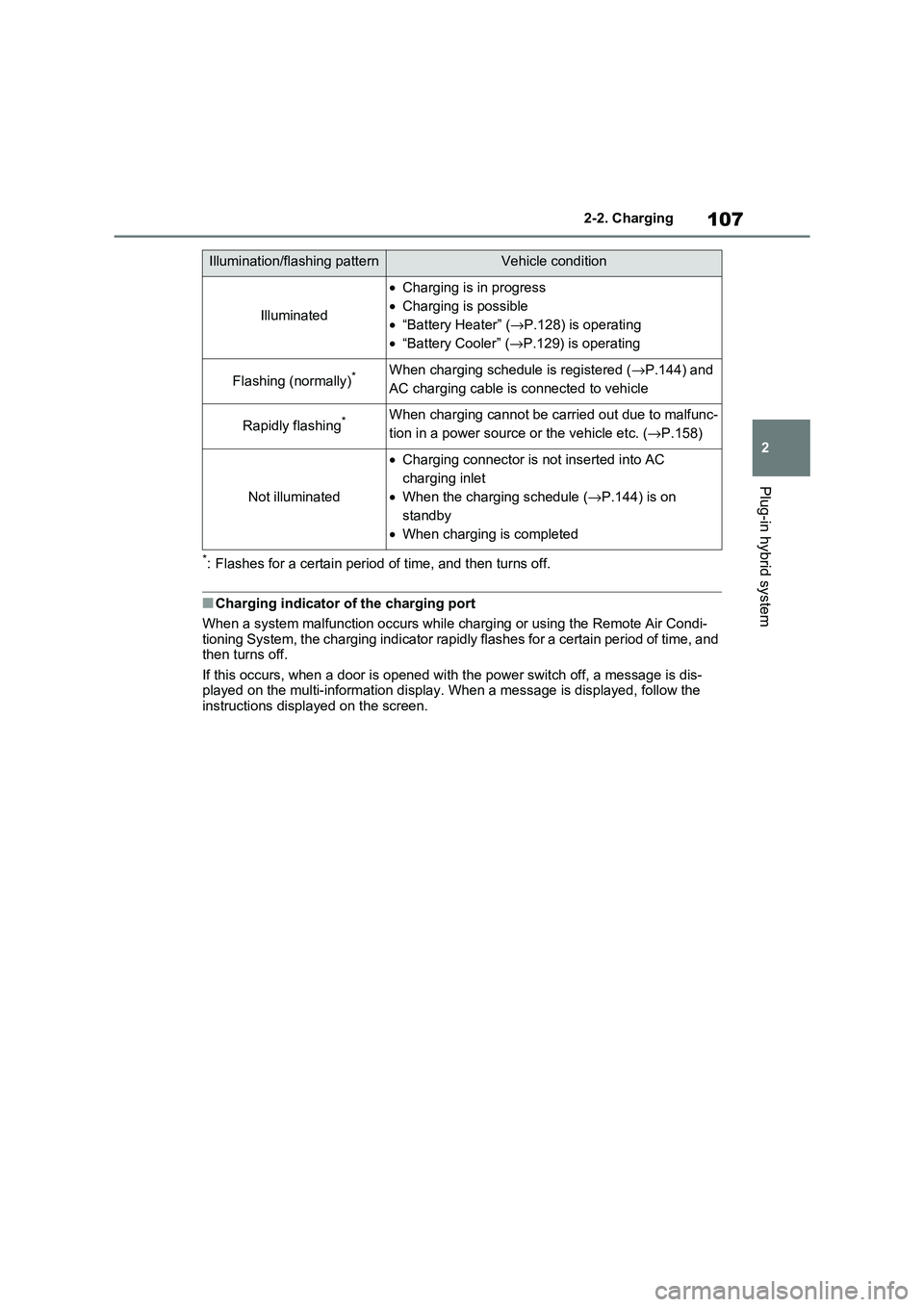
107
2
2-2. Charging
Plug-in hybrid system
*: Flashes for a certain period of time, and then turns off.
■Charging indicator of the charging port
When a system mal function occurs while charging or using the Remote Air Condi-
tioning System, the charging indicator rapidly flashes for a ce rtain period of time, and then turns off.
If this occurs, when a door is o pened with the power switch off, a message is dis-
played on the multi-information display. When a message is displayed, follow the instructions displ ayed on the screen.
Illumination/flashing patternVehicle condition
Illuminated
•Charging is in progress
• Charging is possible
• “Battery Heater” (→P.128) is operating
• “Battery Cooler” (→P.129) is operating
Flashing (normally)*When charging schedule is registered (→P.144) and
AC charging cable is c onnected to vehicle
Rapidly flashing*When charging cannot be carried out due to malfunc-
tion in a power source or the vehicle etc. (→P.158)
Not illuminated
•Charging connector is not inserted into AC
charging inlet
• When the charging schedule (→P.144) is on
standby
• When charging is completed
Page 110 of 666
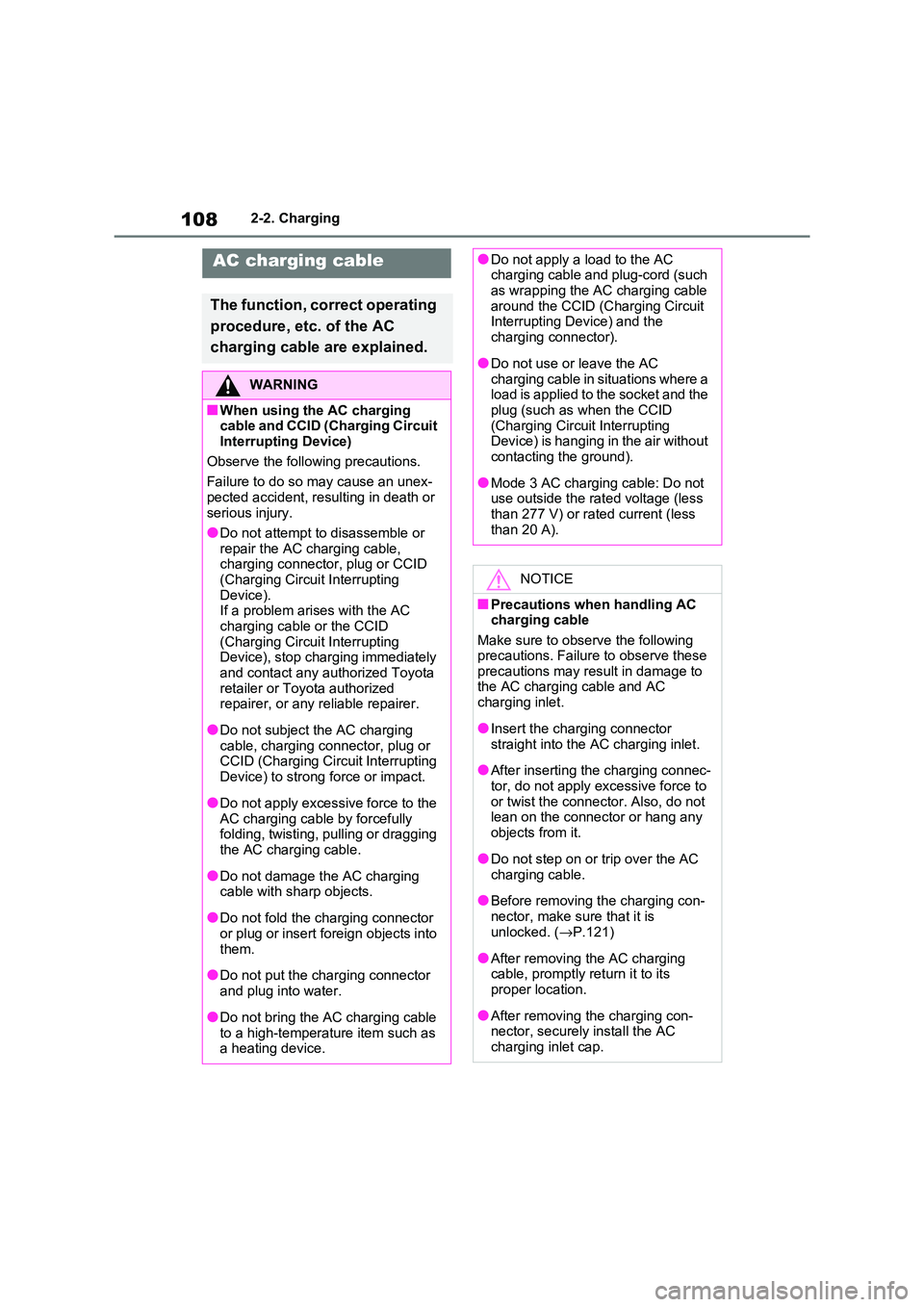
1082-2. Charging
AC charging cable
The function, correct operating
procedure, etc. of the AC
charging cable are explained.
WARNING
■When using the AC charging
cable and CCID (Charging Circuit
Interrupting Device)
Observe the following precautions.
Failure to do so may cause an unex -
pected accident, resulting in death or serious injury.
●Do not attempt to disassemble or
repair the AC charging cable, charging connector, plug or CCID
(Charging Circuit Interrupting
Device). If a problem arises with the AC
charging cable or the CCID
(Charging Circuit Interrupting Device), stop charging immediately
and contact any authorized Toyota
retailer or Toyota authorized repairer, or any reliable repairer.
●Do not subject the AC charging cable, charging connector, plug or
CCID (Charging Circuit Interrupting
Device) to strong force or impact.
●Do not apply excessive force to the
AC charging cable by forcefully folding, twisting, pulling or dragging
the AC charging cable.
●Do not damage t he AC charging
cable with sharp objects.
●Do not fold the ch arging connector
or plug or insert foreign objects into
them.
●Do not put the ch arging connector
and plug into water.
●Do not bring the AC charging cable
to a high-temperature item such as a heating device.
●Do not apply a load to the AC charging cable and plug-cord (such
as wrapping the AC charging cable
around the CCID (C harging Circuit Interrupting Device) and the
charging connector).
●Do not use or leave the AC
charging cable in situations where a
load is applied to the socket and the plug (such as when the CCID
(Charging Circui t Interrupting
Device) is hanging in the air without contacting the ground).
●Mode 3 AC charging cable: Do not use outside the ra ted voltage (less
than 277 V) or rated current (less
than 20 A).
NOTICE
■Precautions when handling AC charging cable
Make sure to observe the following
precautions. Failure to observe these precautions may result in damage to
the AC charging cable and AC
charging inlet.
●Insert the charging connector
straight into the AC charging inlet.
●After inserting th e charging connec-
tor, do not apply excessive force to or twist the connec tor. Also, do not
lean on the connector or hang any
objects from it.
●Do not step on or trip over the AC
charging cable.
●Before removing the charging con -
nector, make sure that it is unlocked. ( →P.121)
●After removing the AC charging cable, promptly return it to its
proper location.
●After removing the charging con -
nector, securely install the AC
charging inlet cap.